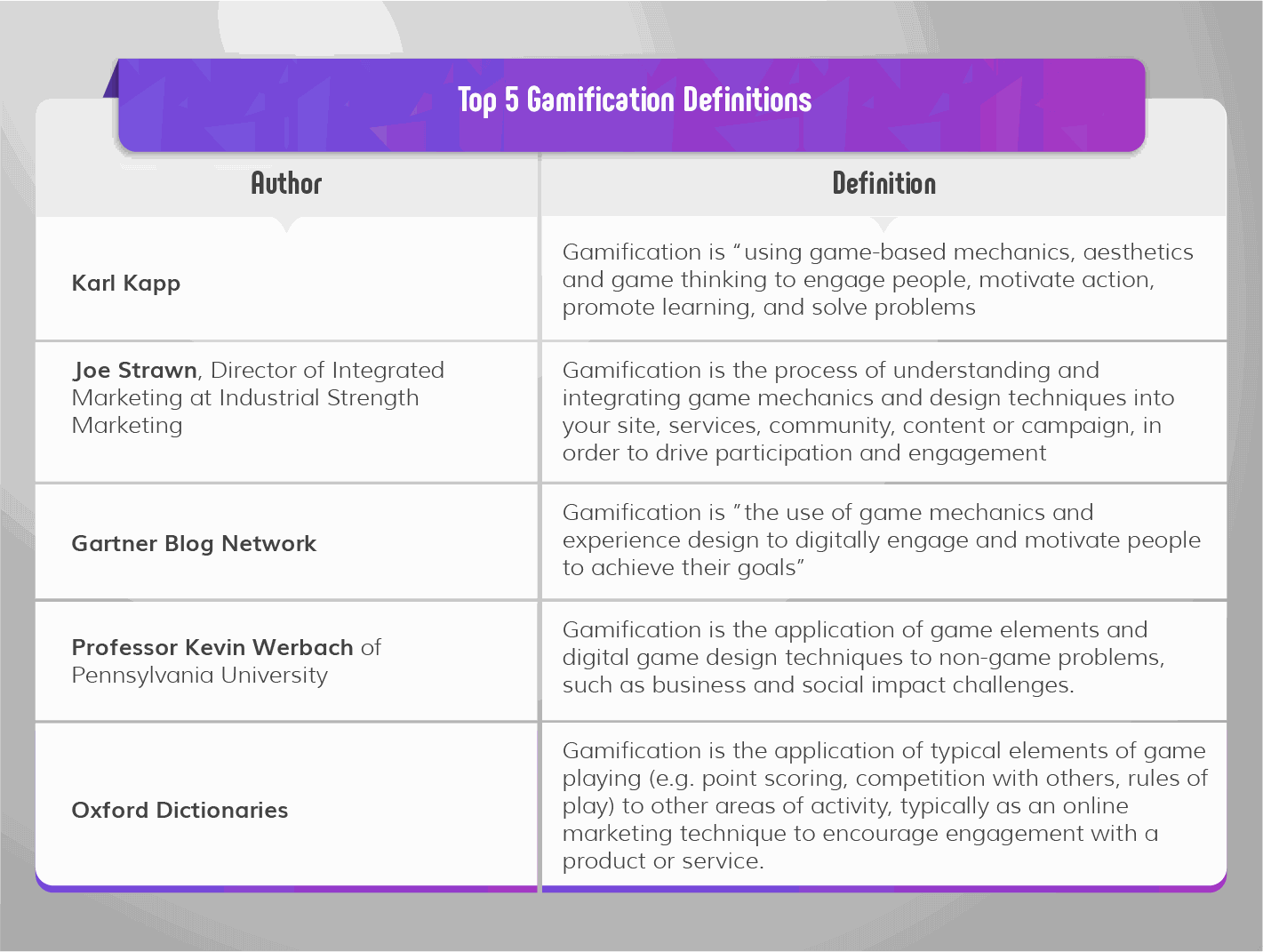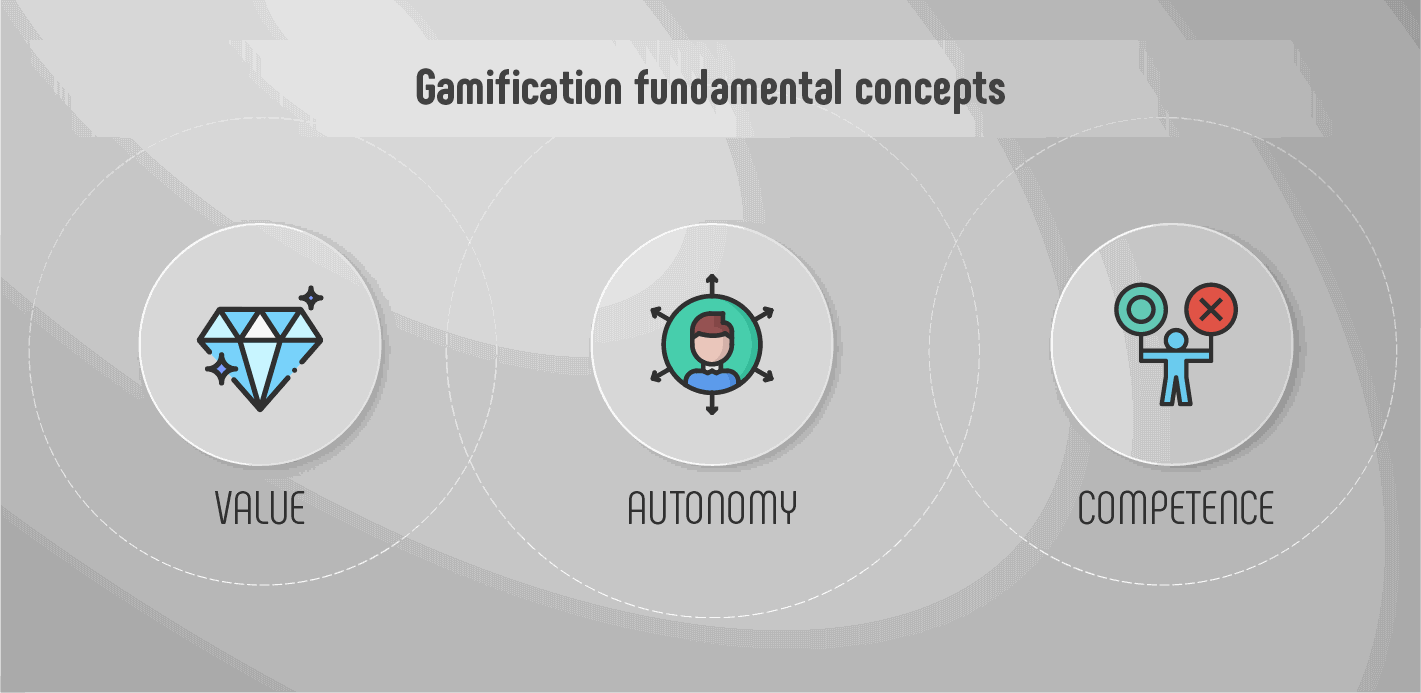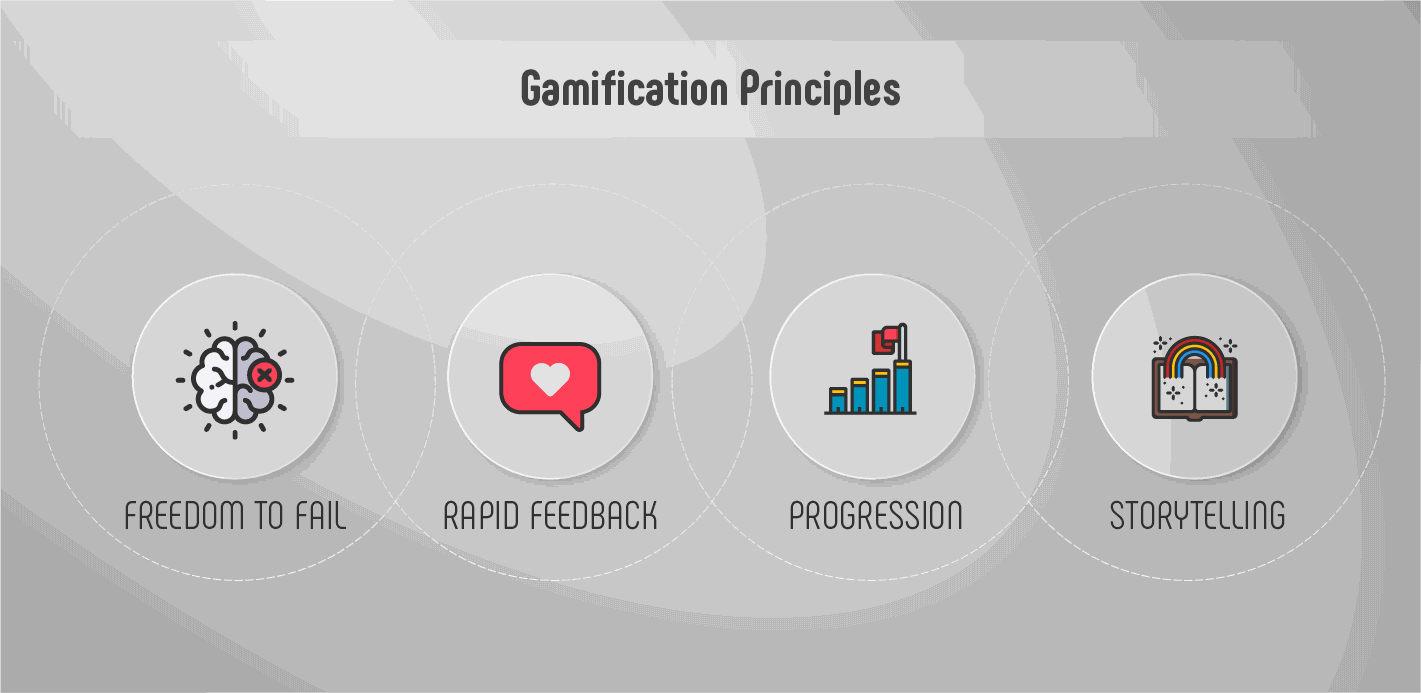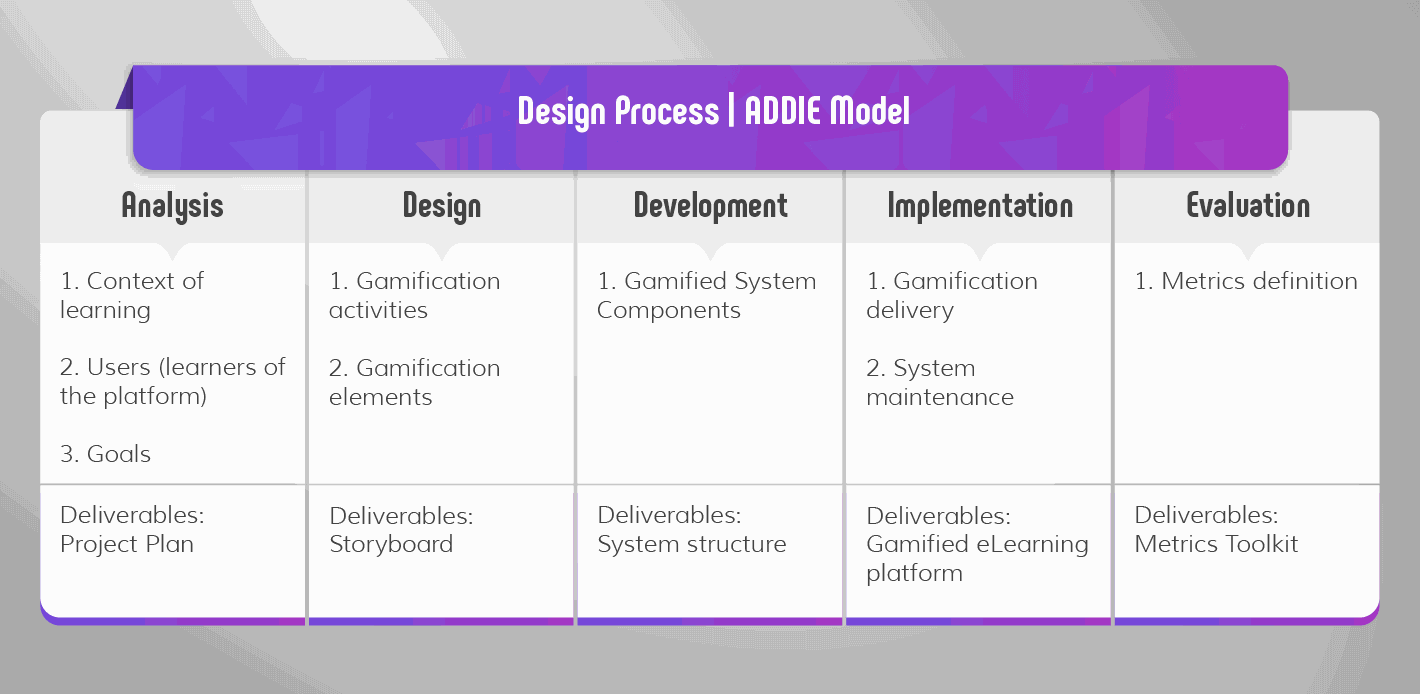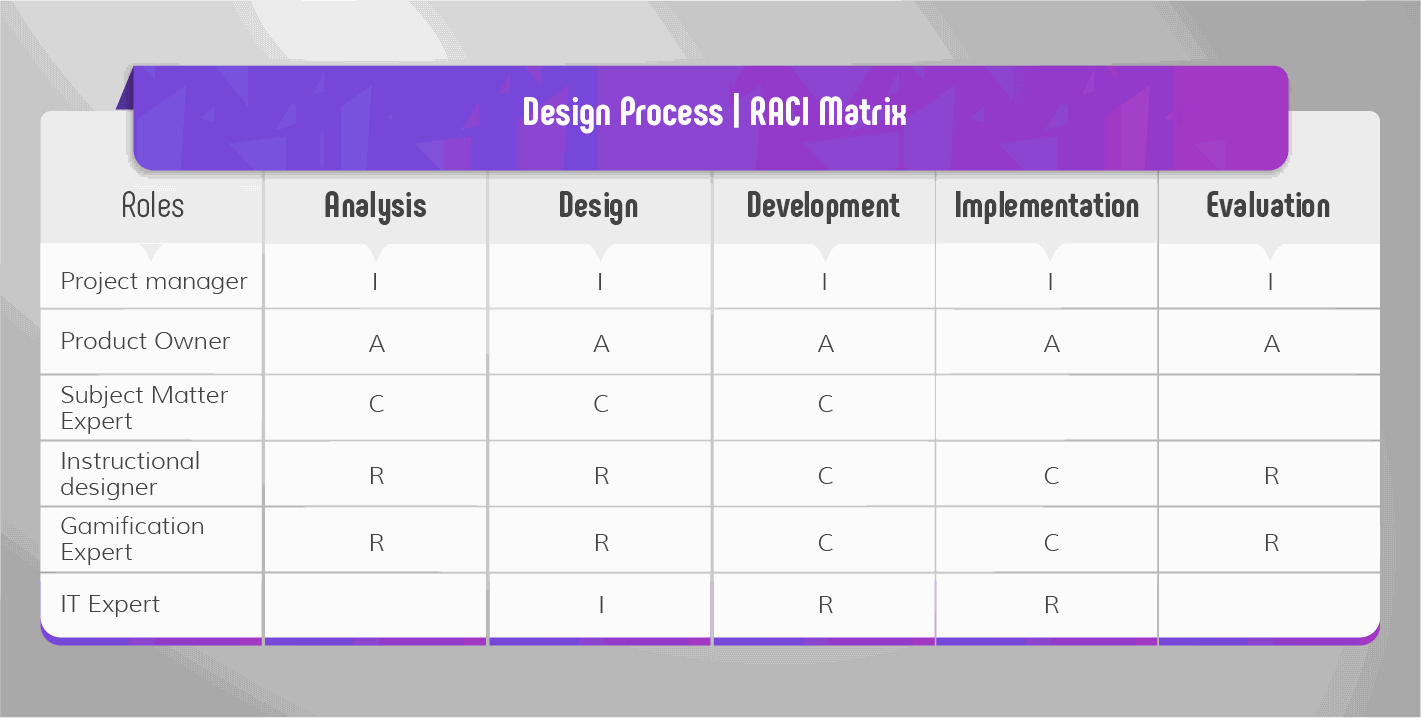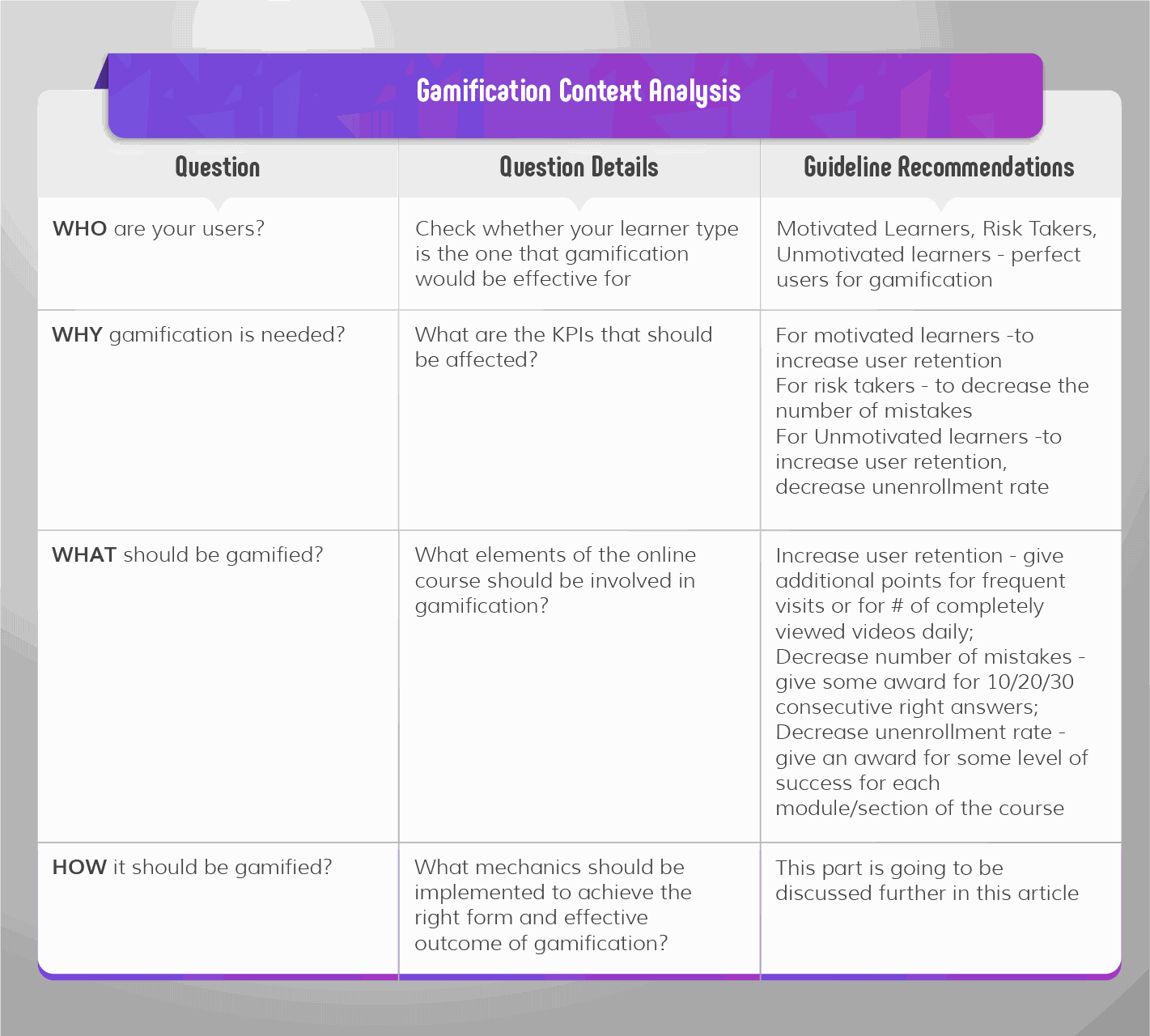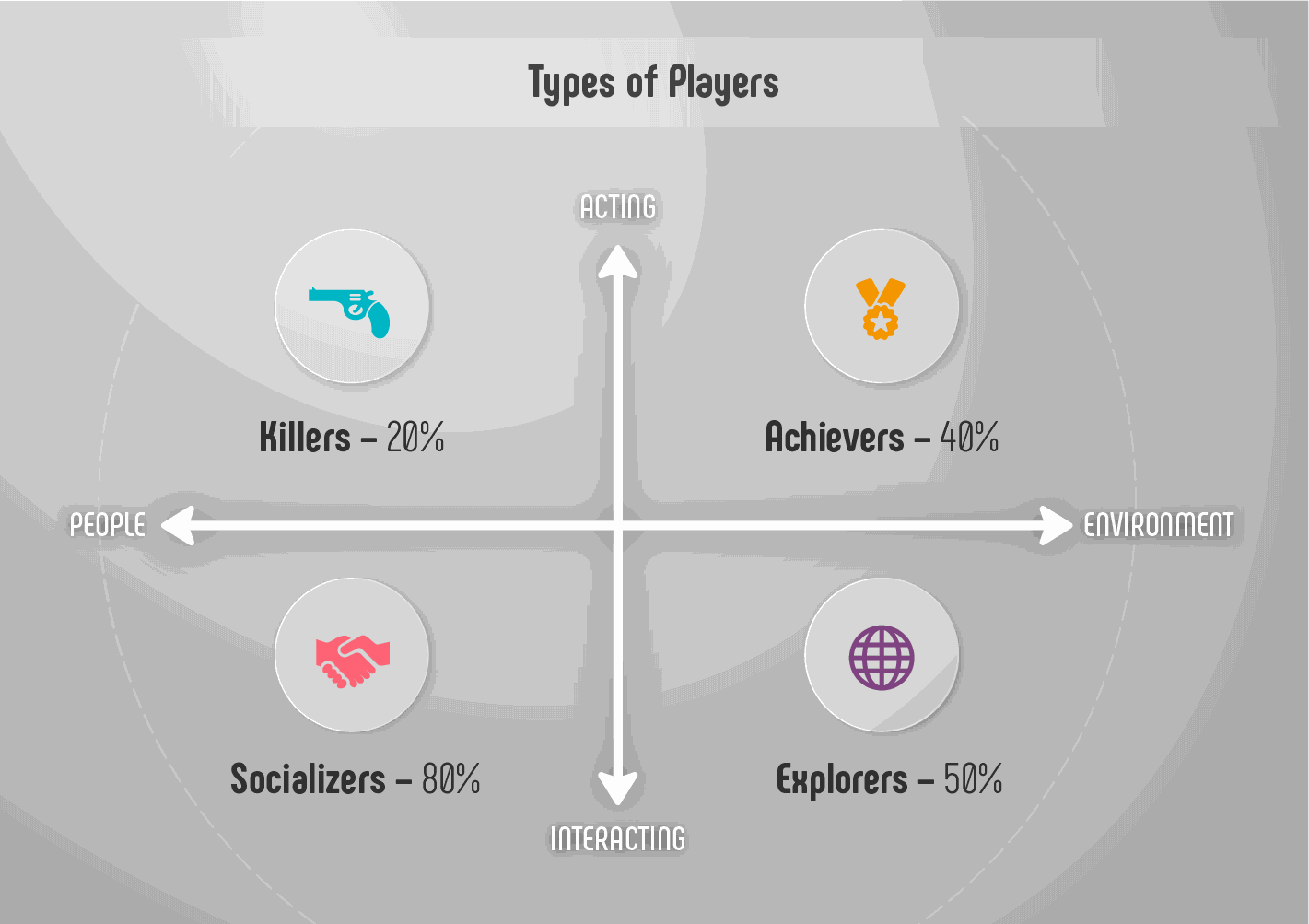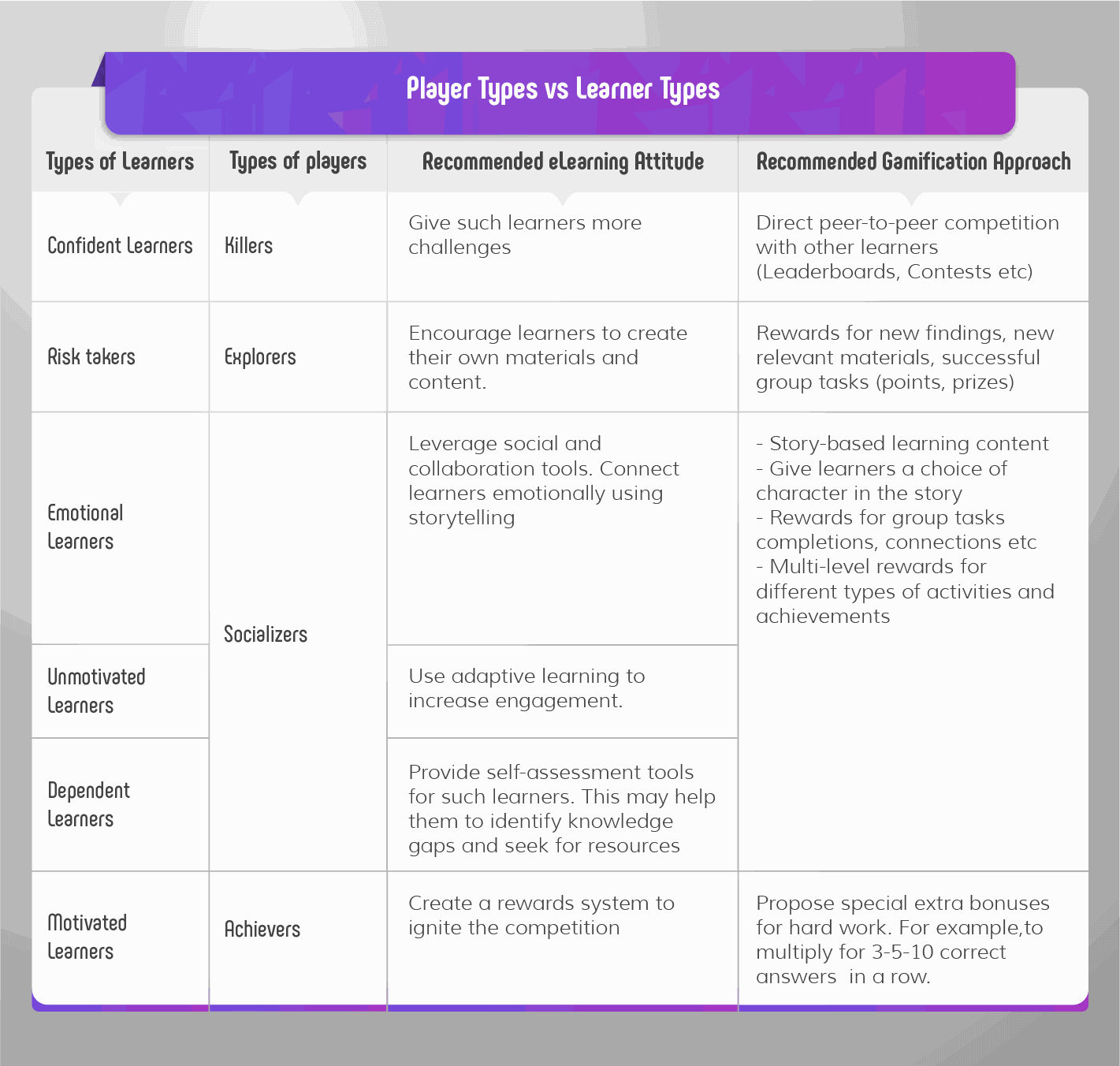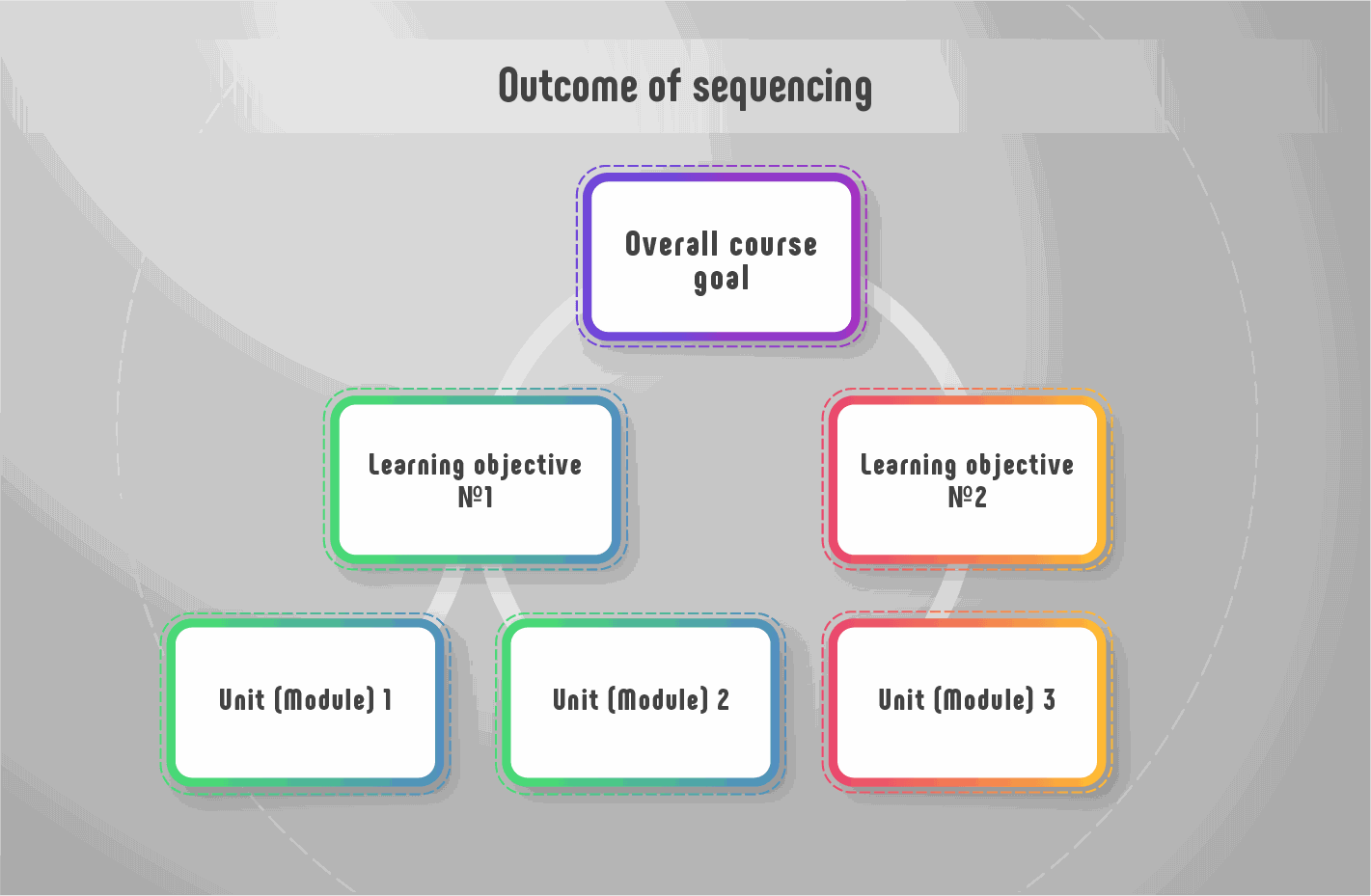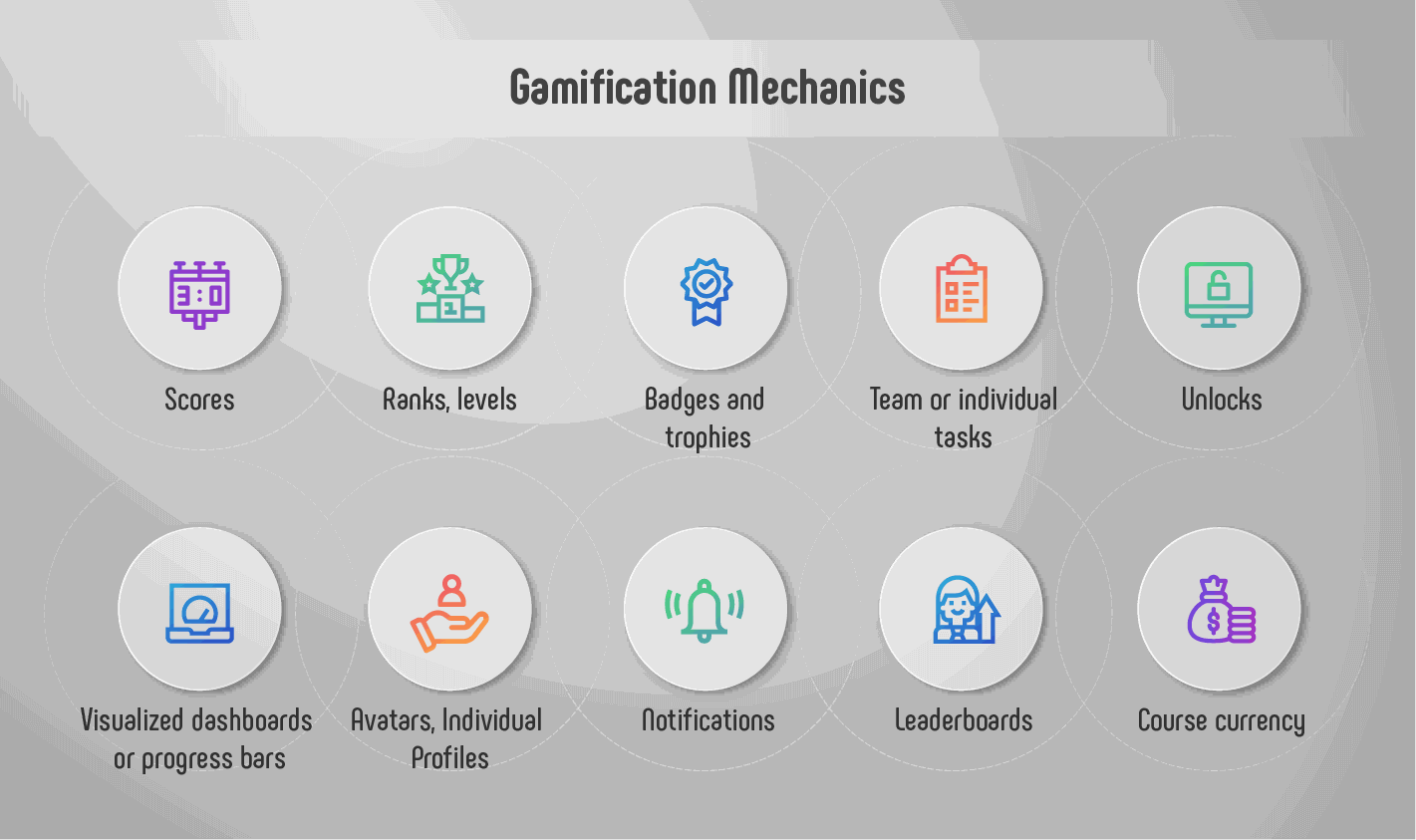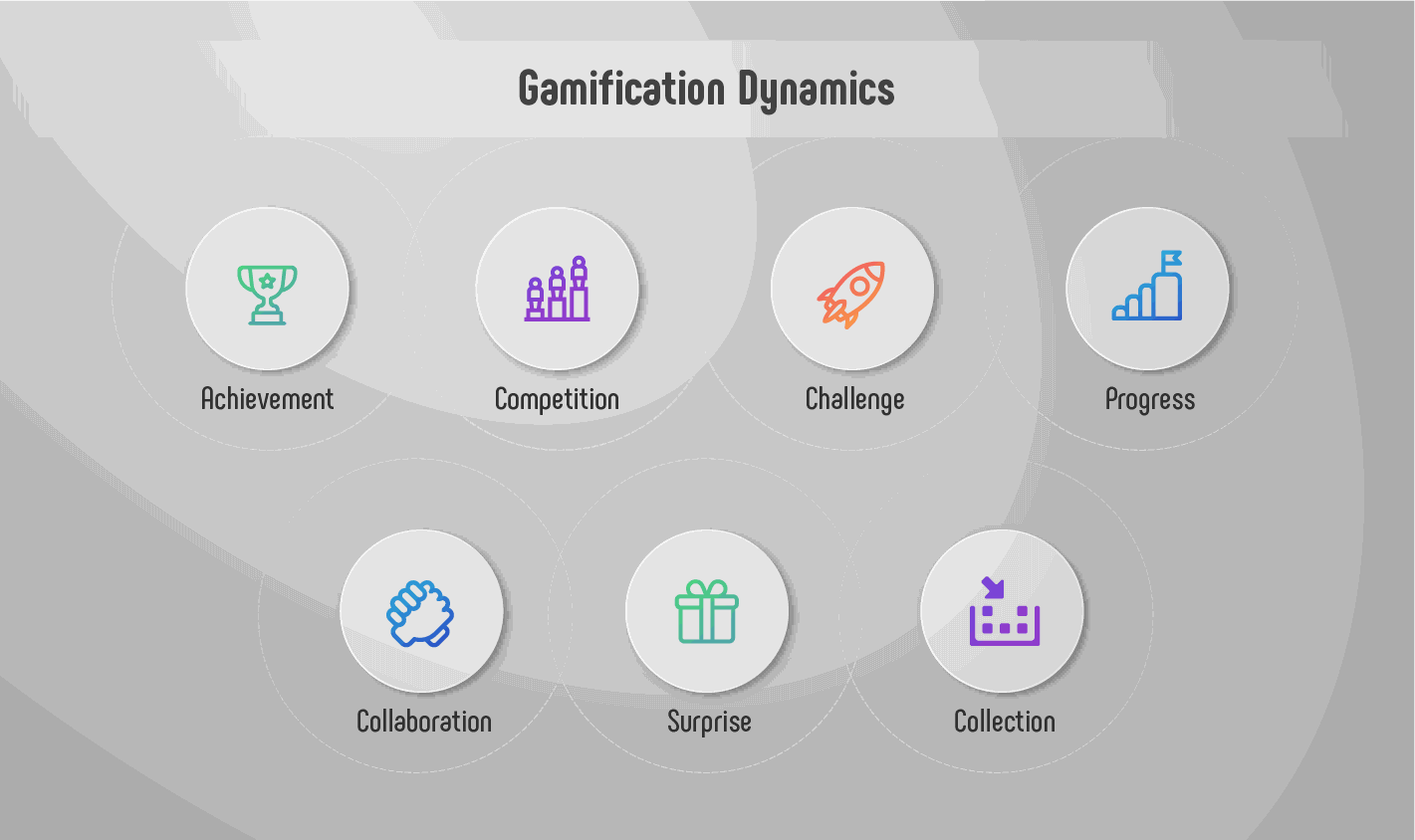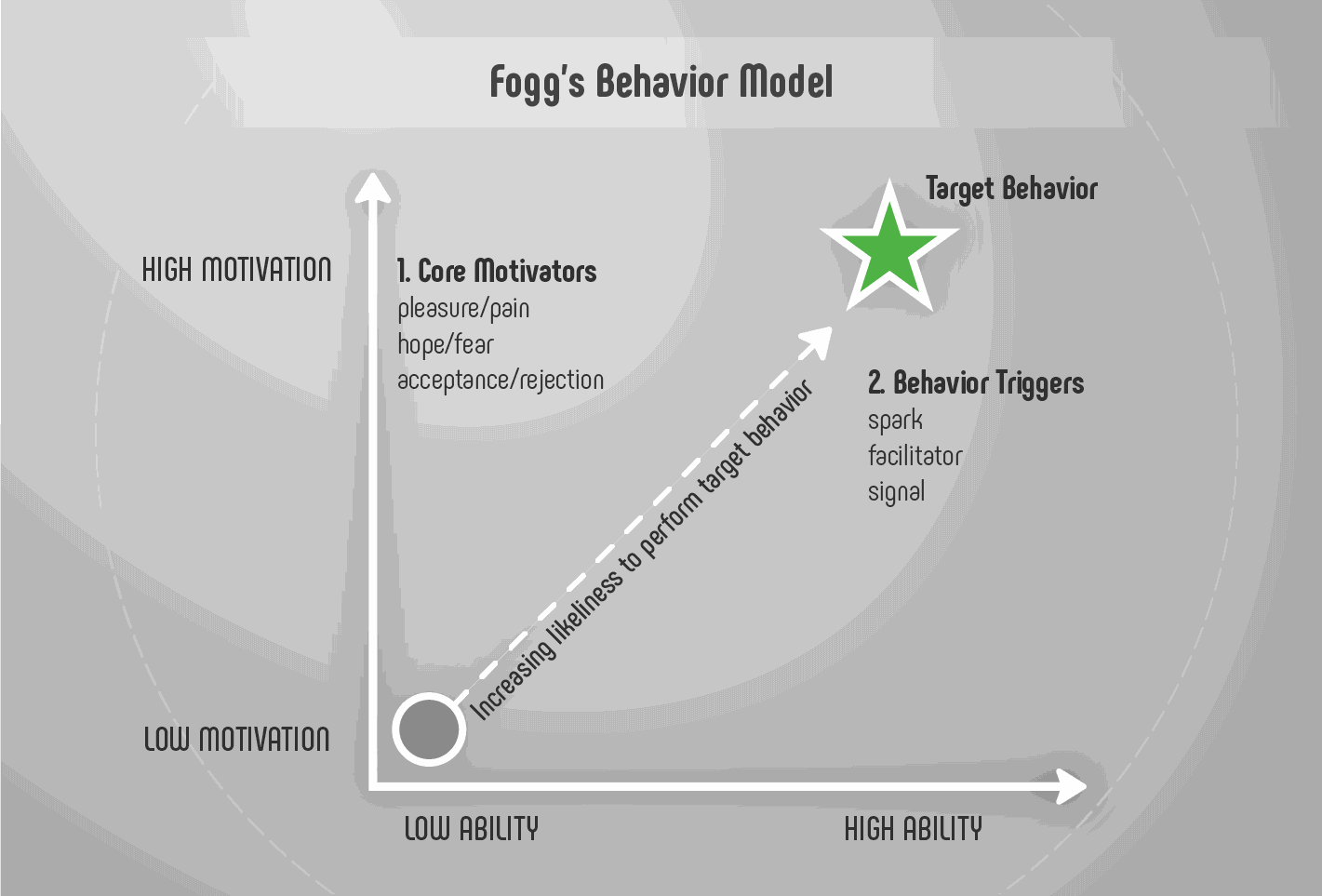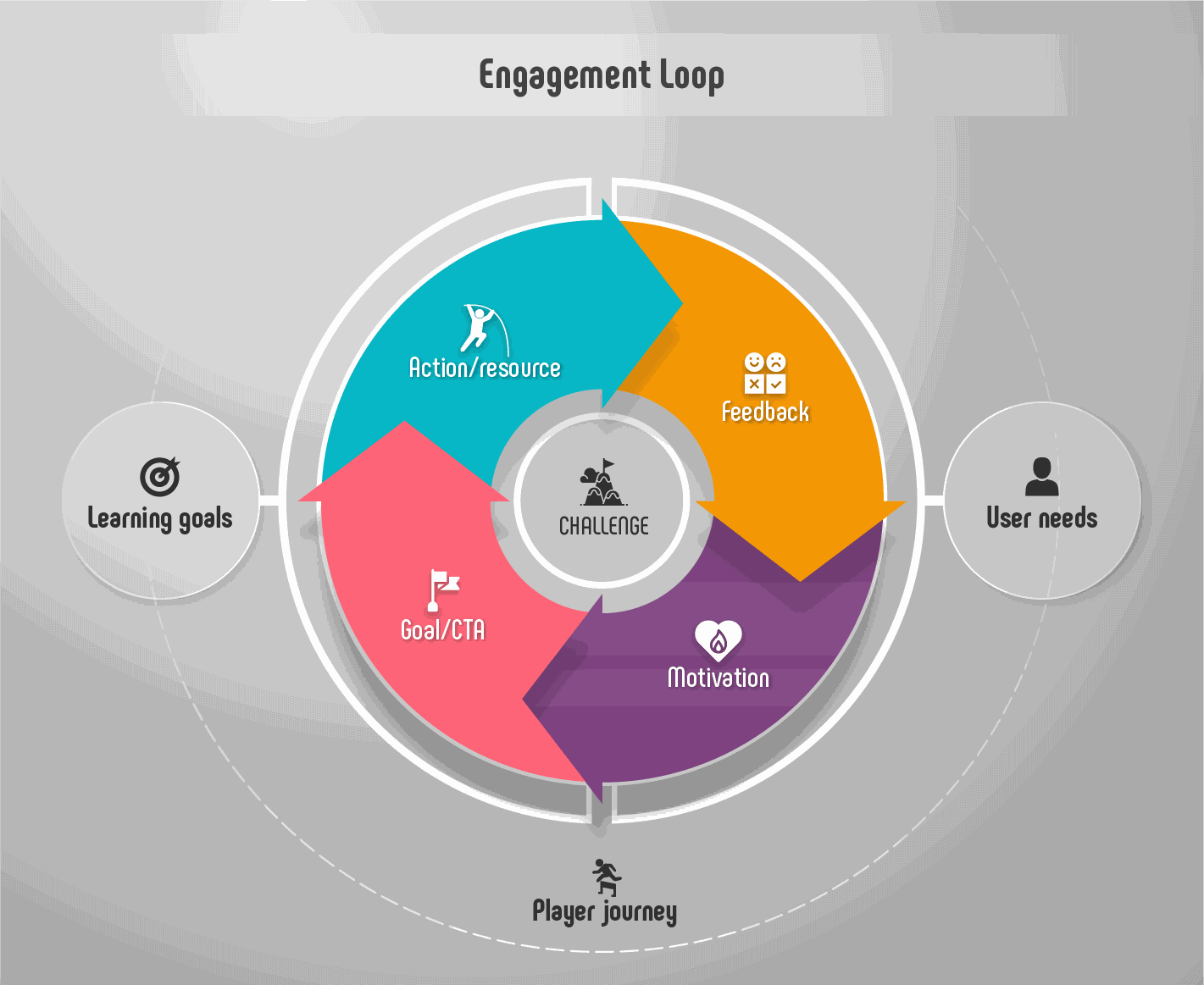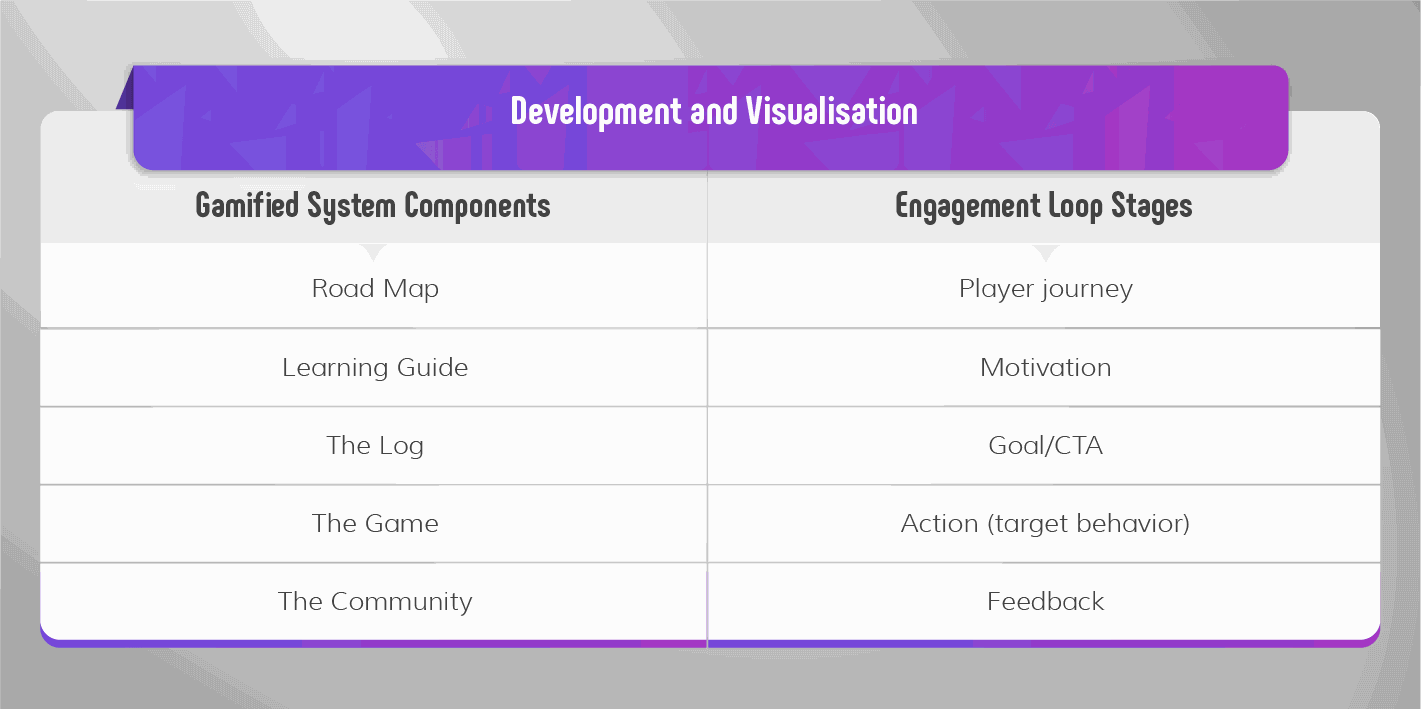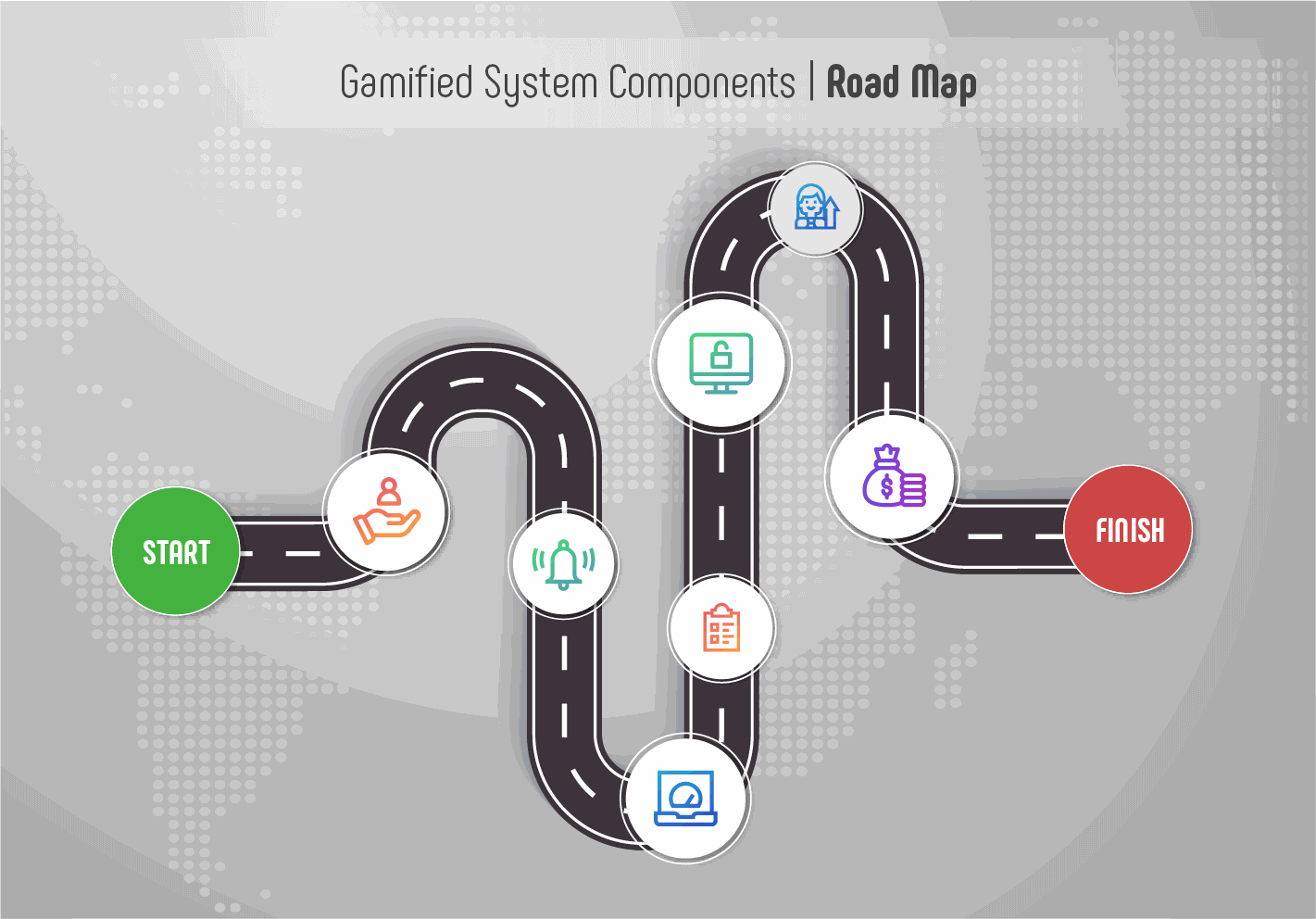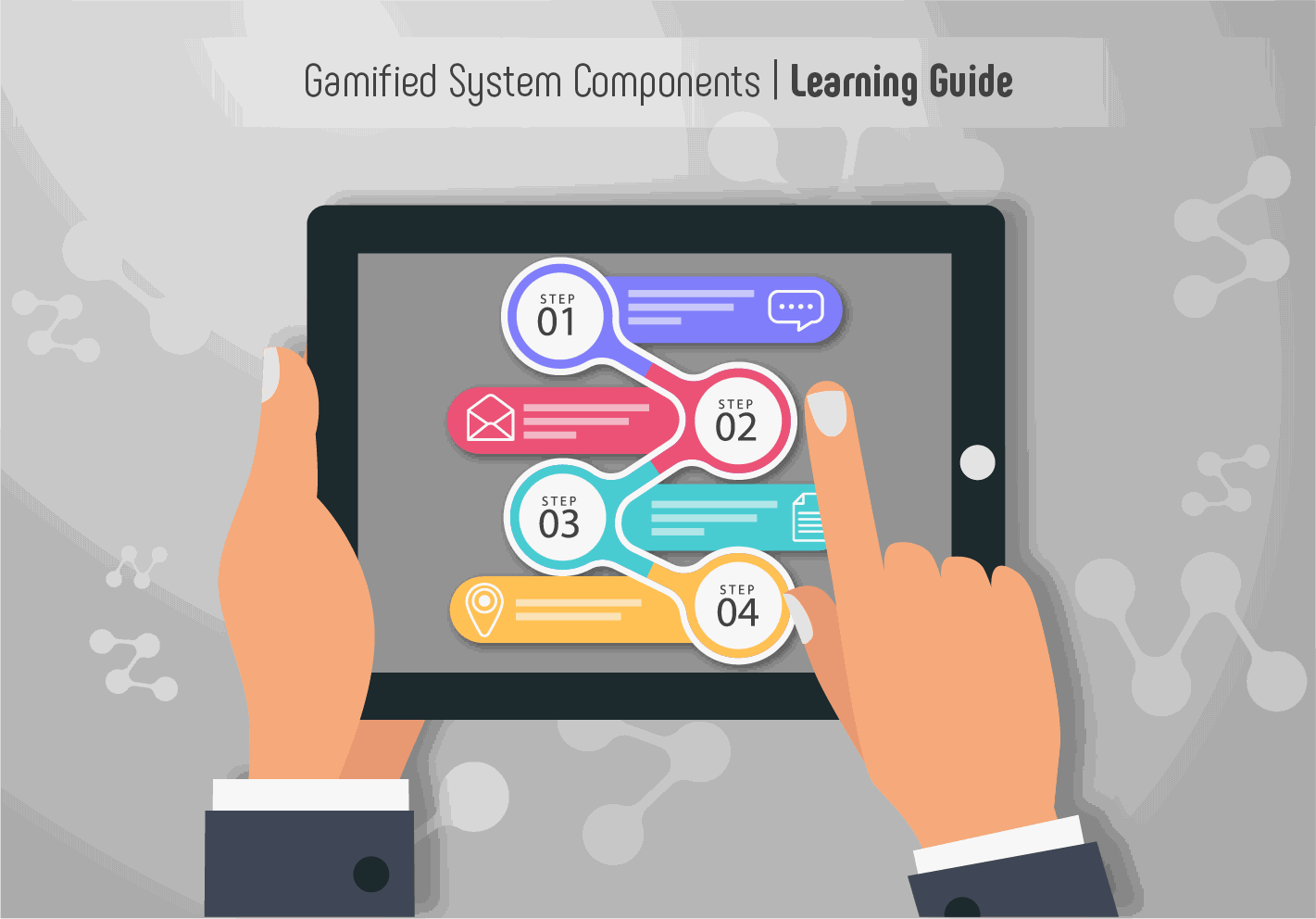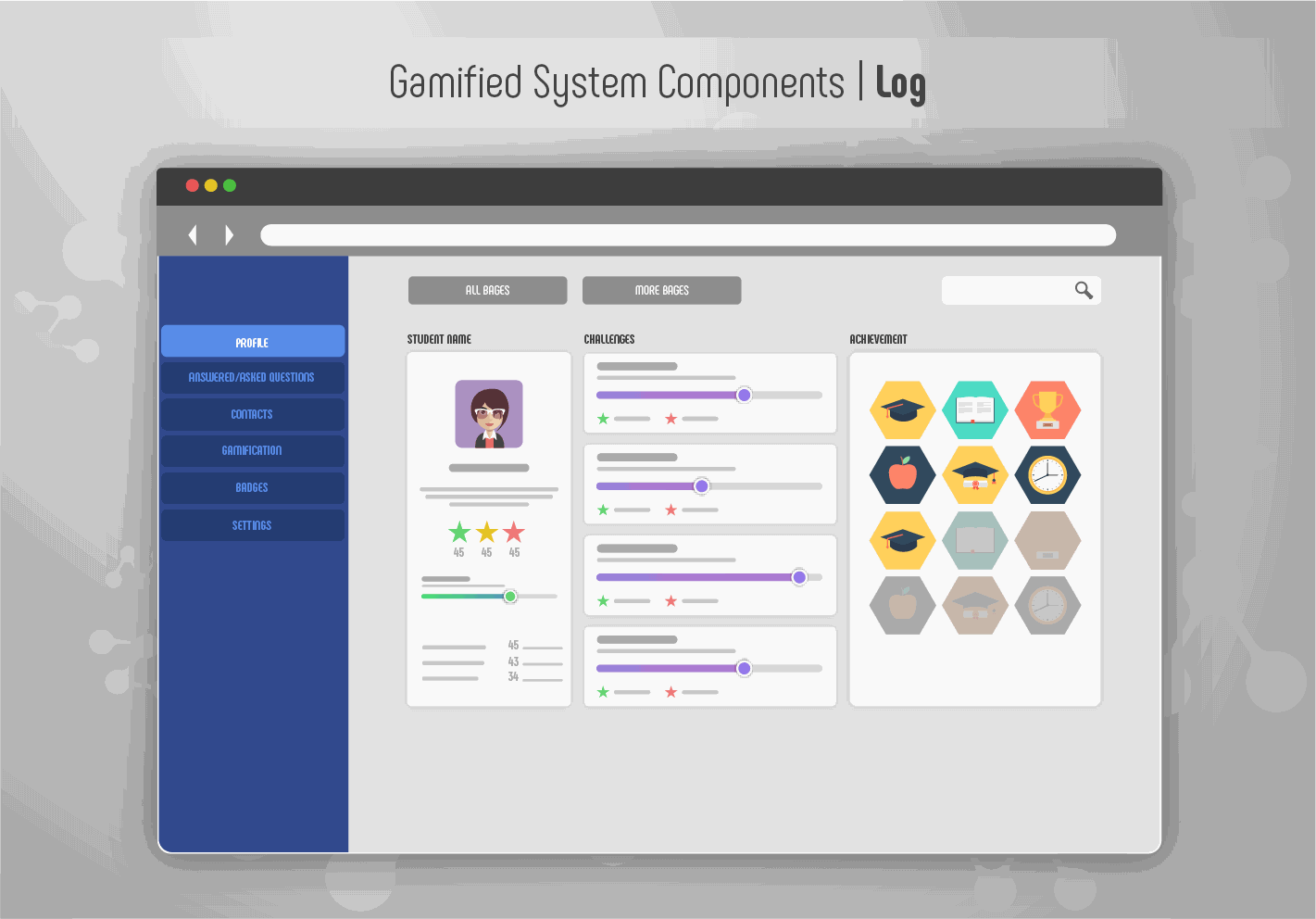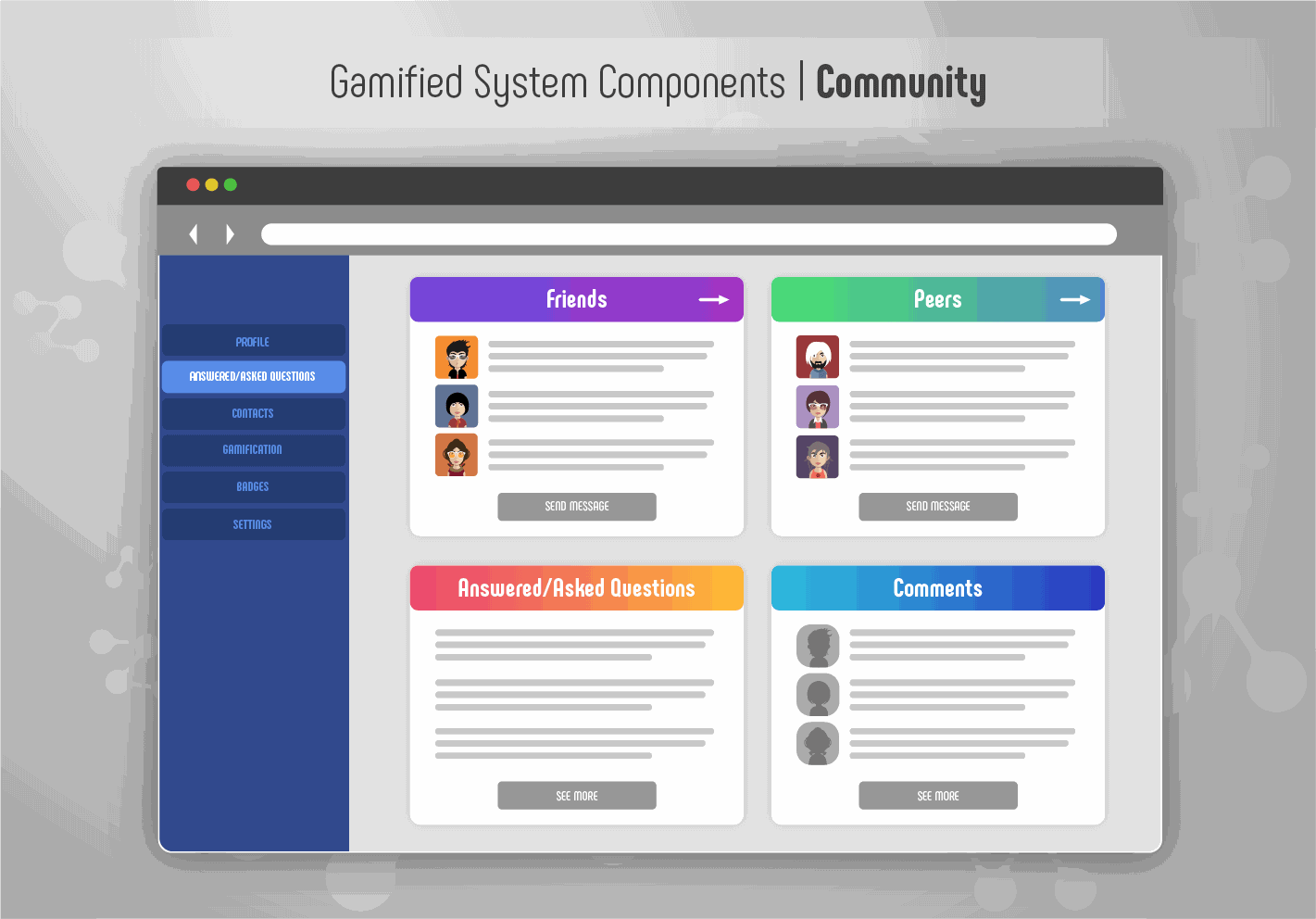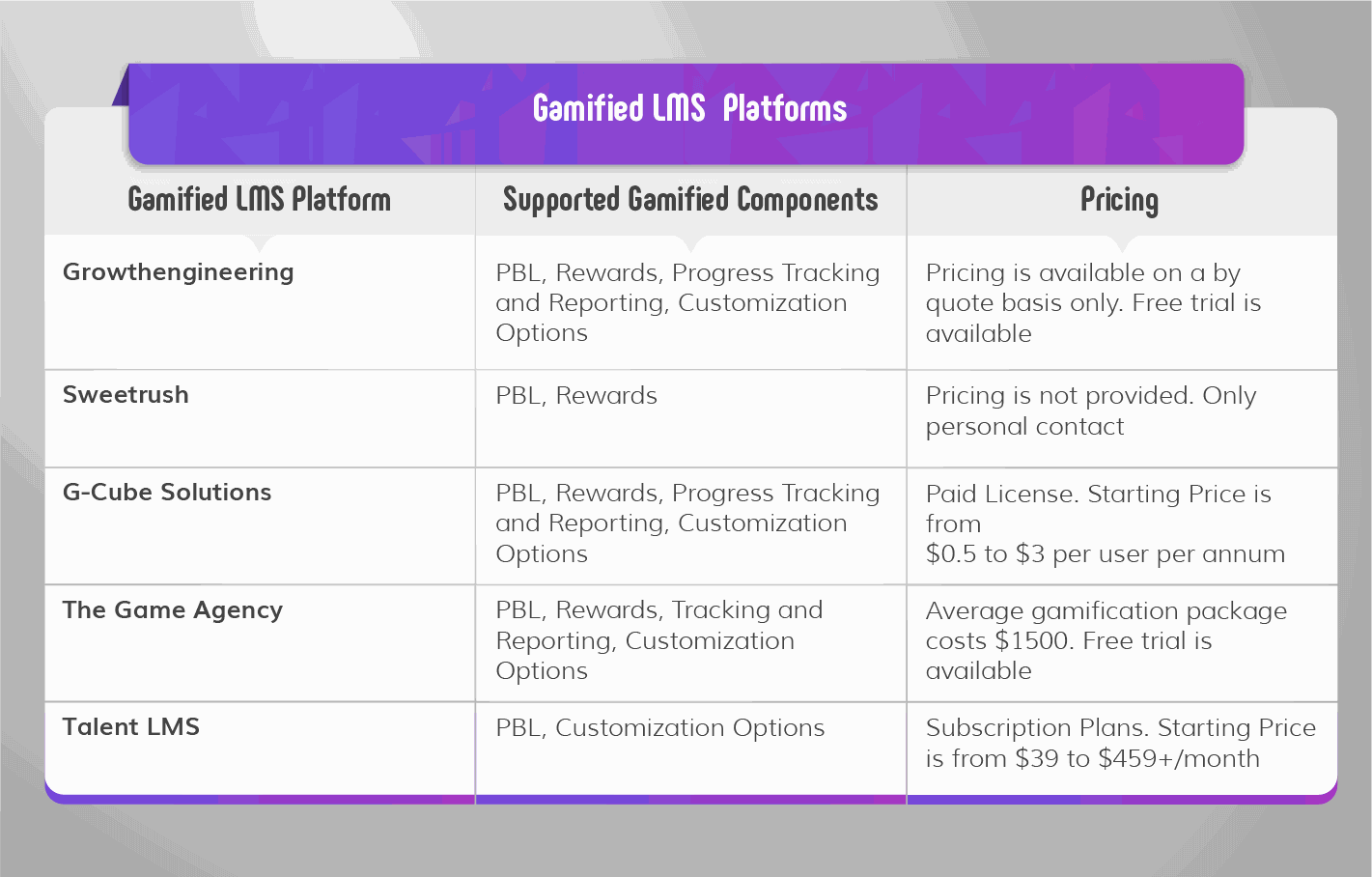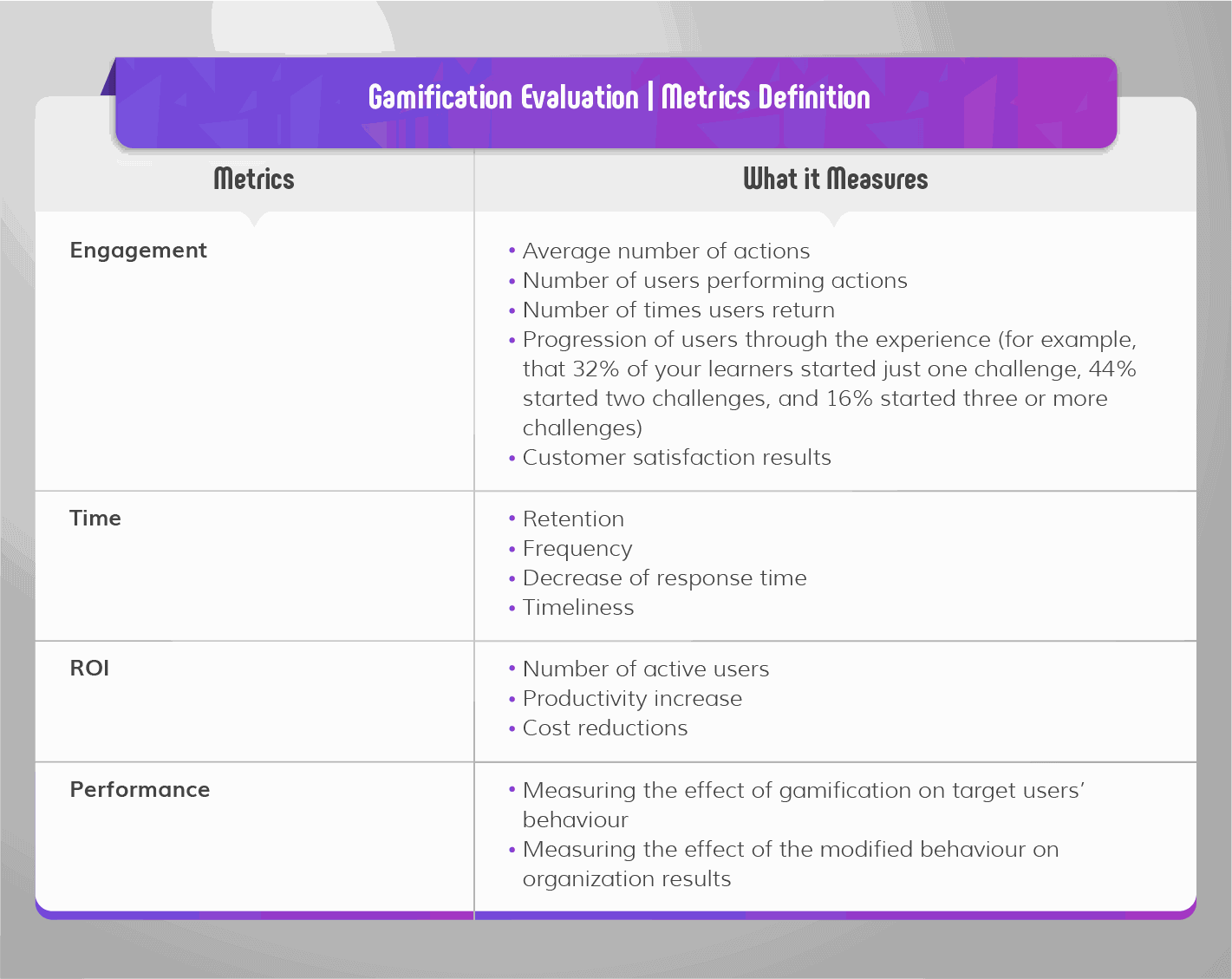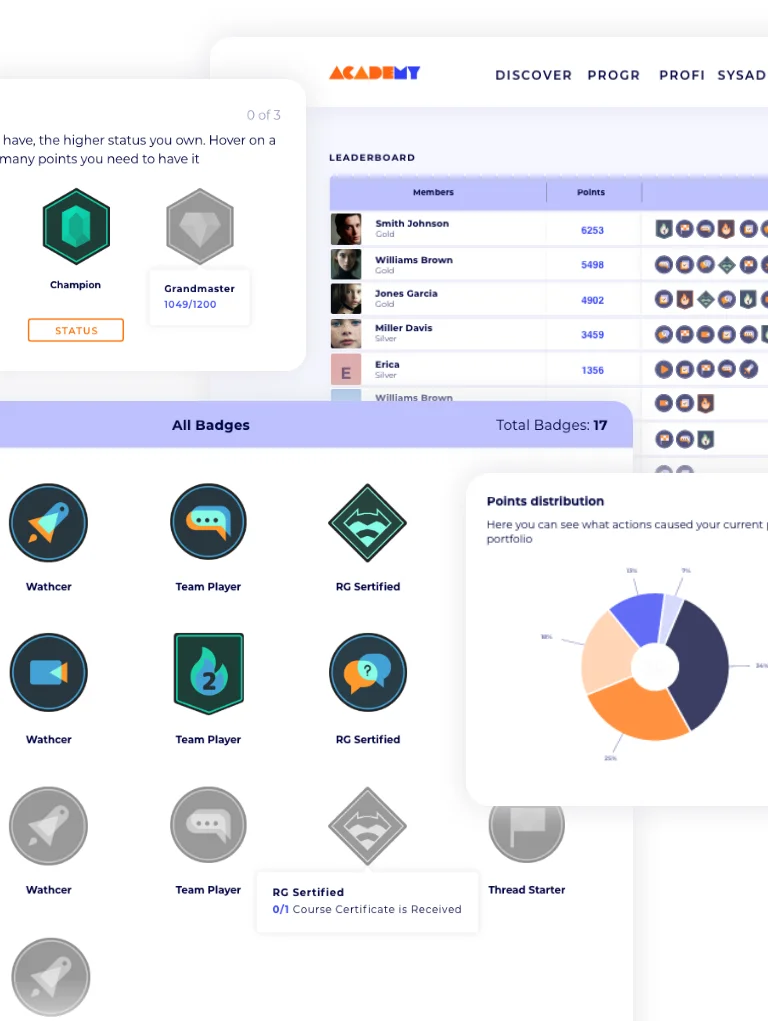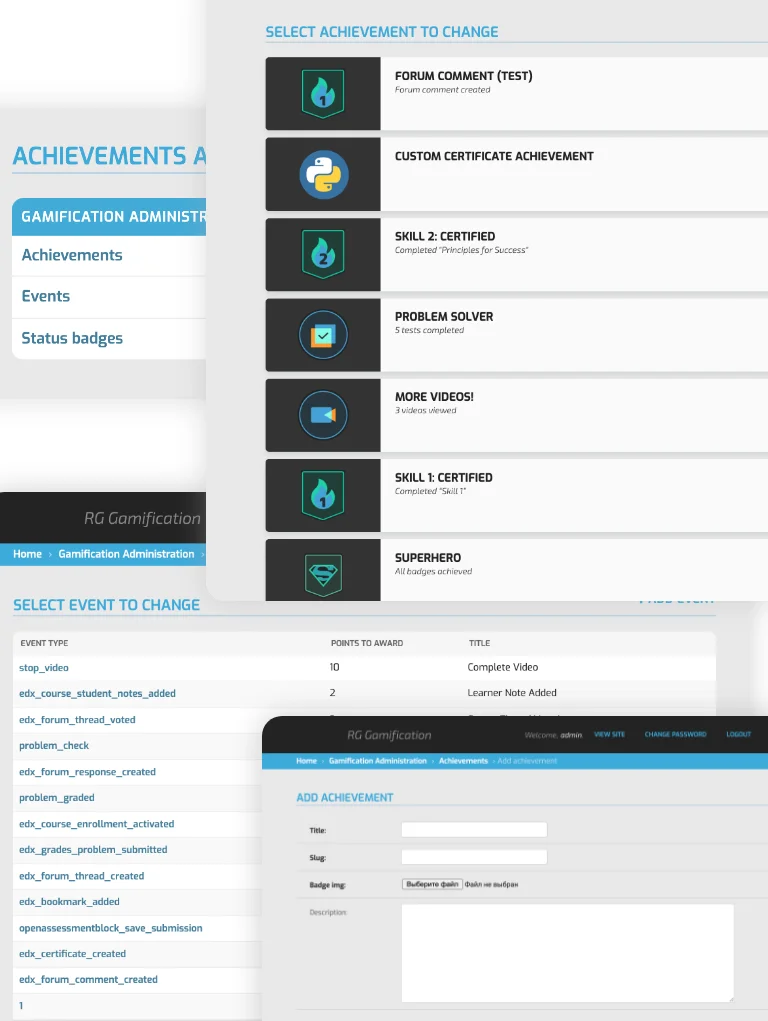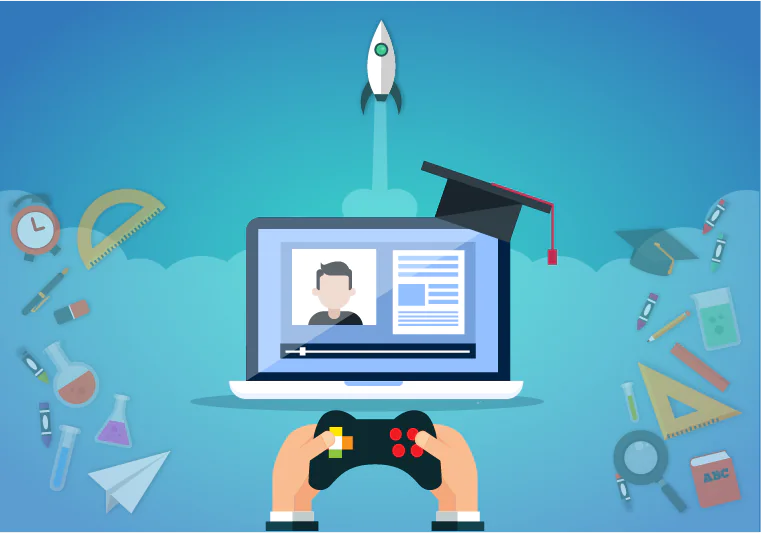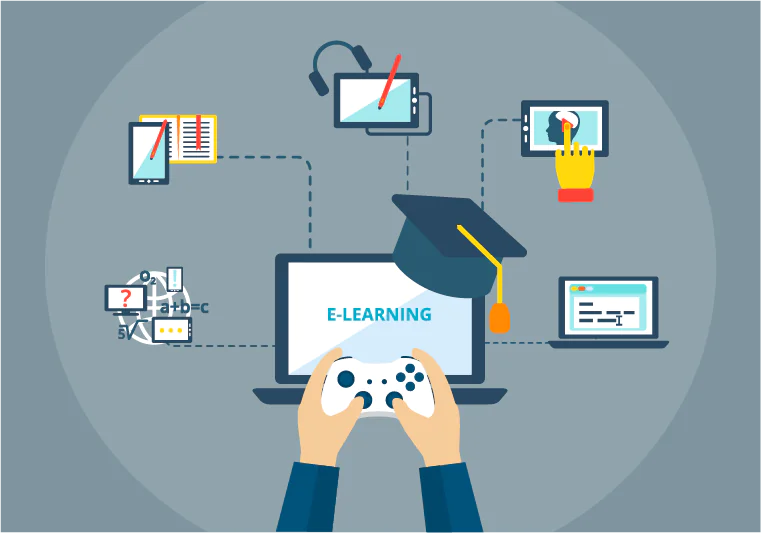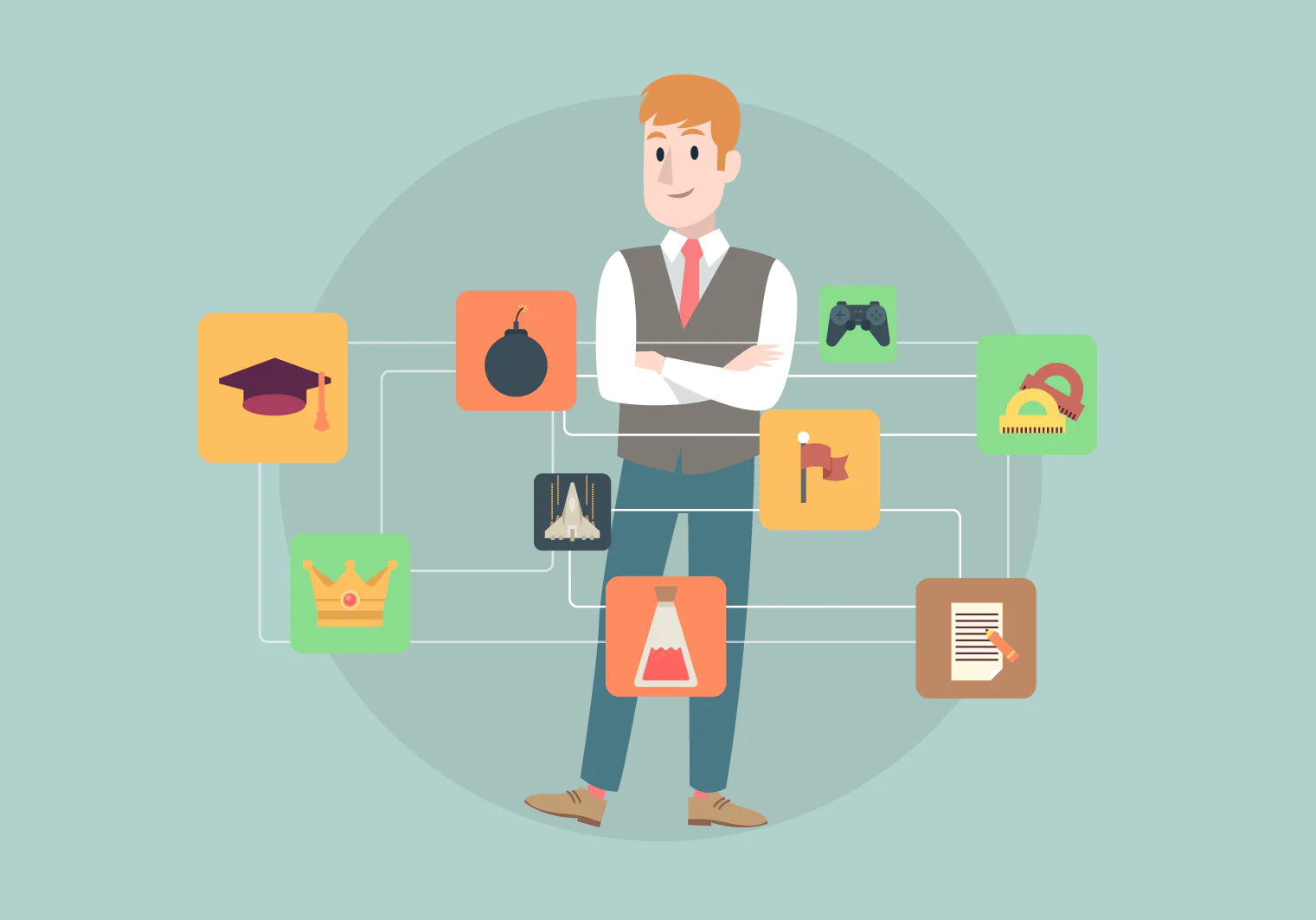Gamification is a powerful tool for engaging learners by incorporating game elements into eLearning content in a way that motivates students to learn. That’s why the gamification market continues to grow, with more and more organizations investing in gamified learning experiences. However, not all companies can achieve a decent return on investment from their eLearning gamification efforts. This is often due to two reasons:
- they don’t treat eLearning gamification as a serious endeavour;
- they don’t implement it effectively.
In this blog post, we aim to address these issues by clearly defining eLearning gamification and a comprehensive guide to effective design. Specifically, we will focus on two key principles of successful eLearning gamification: treating it as a serious business initiative and designing it to engage learners and align with learning objectives.
What is Gamification?
What exactly is gamification in eLearning? Despite its popularity, there is still some confusion about what gamification really means. There is no single academic definition that fully describes the concept of “eLearning gamification.” To help clarify this, we’ve compiled 5 best definitions from top influencers in the field.
A clear understanding of gamification can make it easier to develop an effective gamification strategy and tactics. It allows you to test your approach’s relevance and potential effectiveness by asking yourself, “Will it do what it’s supposed to do?” However, building a successful gamified eLearning system is not a simple process. To build an effective gamification strategy, you need to understand the fundamental concepts and principles of gamification and use them as landmarks in the planning and implementation processes.
What is gamification in eLearning?
Gamification in eLearning involves integrating game mechanics, such as points, badges, leaderboards, and levels, into online learning environments to make the learning experience more engaging, enjoyable, and effective for learners.
Gamification Fundamental Concepts
3 basic principles of gamification, drawn from motivation and game theory, were formulated by Michelle Schwartz, an Instructional Design and Research Strategist at Ryerson University. These principles are critical to understanding how gamification can be used in eLearning:
Autonomy: Learners are more likely to stick to a task when they feel like they are in charge of it. In game-based learning, learners are more engaged when given choices and decisions that impact their next steps. To some extent, such a principle is also implemented in adaptive learning.
Value: Good games provide value that is available outside of the game environment. This can mean developing strategic thinking, increasing reaction speed, or simply becoming smarter. In eLearning, the “Value” principle means that learners are more engaged when they feel that what they are learning can be applied in real life. That is why different types of simulations, including VR, are used.
Competence: When students complete a task and move on to the next level, they get a sense of their development as learners. According to JISC, “If you know that something demands hard work as opposed to some talent, you are more likely to keep trying it.” The better learners become at a task, the more likely they are to continue doing it.
3 Gamification Examples
Example 1: Duolingo
Duolingo, a language learning platform, uses gamification elements like points, levels, and streaks to motivate users to practice and learn languages consistently. Users earn experience points (XP) for completing lessons, quizzes, and tests, allowing them to level up and track their progress. Duolingo also incorporates streaks to encourage daily practice, rewarding users with virtual currency called “lingots” for maintaining consistent study habits. Additionally, users can join clubs or compete with friends to foster a sense of community and friendly competition. This combination of elements creates an engaging and enjoyable language learning experience, leading to improved retention and progress.
Example 2: Codecademy
Codecademy, an online coding learning platform, incorporates challenges, quizzes, and badges to encourage learners to progress through programming courses. As learners complete coding exercises, they earn points and badges, which visually represent their accomplishments. Codecademy’s interactive coding environment provides instant feedback, allowing learners to correct mistakes and gain confidence in their skills. The platform also offers timed coding challenges, encouraging learners to apply their knowledge and skills under pressure. These gamification elements create a motivating and engaging learning experience that helps users develop valuable coding skills.
Example 3: Kahoot!
Kahoot!, an educational quiz platform, uses competitive game mechanics like points and leaderboards to make learning fun and interactive in a classroom setting. Teachers and instructors can create custom quizzes, which students can then join using a unique game PIN. As students answer questions, they earn points based on speed and accuracy, with top performers displayed on a real-time leaderboard. This competitive element encourages students to stay focused and engaged during the quiz. Kahoot! also enables users to create teams, fostering collaboration and teamwork. The combination of competition, collaboration, and instant feedback makes Kahoot! an effective tool for reinforcing learning concepts in a fun and engaging way.
Gamification Designing Principles
Dichiva Darina from the Computer Science Department at Winston Salem State University made a study of different game designing principles that have been used in education to identify common principles implemented in all of those cases. As a result, she formulated four main eLearning gamification principles.
- Freedom to fail. There should be a low level of risk associated with certain submissions, and learners should get multiple attempts to succeed. Similar to how video games give players a certain number of tries or ‘lives’ to complete the game or allow players to restart from a previous point, learning games can eliminate a conventional focus on a final grade and fear of failure, and encourage students to experiment, take risks, and try again.
- Rapid feedback. Learners should receive immediate feedback and rewards. Games typically provide frequent targeted feedback as a game is played, either after the completion of an individual task or at the end of each level.
- Progression. Learners should be able to visually assess their progress on their journey to mastery. When games are divided into levels, players have an opportunity to practice what they have learned at recent stages, often building up requirements to apply all those skills at once to complete a final level.
- Storytelling. The most successful games usually involve a story. Structuring content inside a narrative and asking players to participate in the creation of the story is a way to success.
Following the principles described above, you can build a successful gamified online course. But what is the process? Who needs to do what to ignite that eLearning gamification magic? Here is the ultimate guide for online learning gamification implementation.
How to use gamification in corporate LMS development?
Step 1: Identify the learning objectives and determine how gamification can enhance the learning experience and outcomes.
Start with understanding the learning objectives of your corporate training program. Determine the specific skills, knowledge, or behavior you want your learners to acquire or improve. Then, consider how gamification elements can help support and enhance these objectives. For instance, if your goal is to improve teamwork, consider using collaborative game mechanics like team challenges or group leaderboards. On the other hand, if your objective is to promote continuous learning, you can use rewards or badges to encourage consistent engagement.
Step 2: Choose appropriate game mechanics that align with your learning objectives and appeal to your target audience.
Select game mechanics that align with your learning objectives and resonate with your target audience. Research your audience’s preferences, interests, and learning styles to ensure the chosen mechanics are engaging and effective. This may involve conducting surveys, focus groups, or interviews with your target learners. Some popular game mechanics include points, badges, leaderboards, levels, and challenges. Remember to strike a balance between the complexity of the mechanics and the ease of use, so that learners can focus on the learning process without being overwhelmed.
Step 3: Implement gamification elements in your LMS and ensure seamless integration with your eLearning content.
Once you’ve chosen the appropriate game mechanics, work with your LMS provider or development team to implement them within your platform. The gamification elements should seamlessly integrate with your eLearning content, complementing the learning process without distraction. This may require customizing the LMS or working with an LMS that already offers built-in gamification features. Regularly test and refine your gamified learning experience to ensure it remains engaging, effective, and aligned with your learning objectives.
Benefits of gamification in e-learning
Benefit 1: Increased engagement and motivation
Gamification encourages active participation by making learning more enjoyable and rewarding. By incorporating game mechanics like points, badges, and leaderboards, learners feel a sense of accomplishment and are motivated to continue engaging with the learning material. This increased motivation leads to a more engaging and effective learning experience.
Benefit 2: Improved knowledge retention
The interactive and immersive nature of gamified eLearning helps learners better retain information. When learners actively participate and interact with the learning content, they are more likely to remember concepts encountered in a fun and engaging context. Gamification also encourages repetition and practice, which further reinforces learning and promotes long-term retention.
Benefit 3: Enhanced collaboration and competition
Social elements, such as leaderboards and team challenges, foster community, collaboration, and healthy competition among learners. By creating opportunities for learners to work together or compete against each other, gamification enhances the learning experience, making it more enjoyable and effective. Collaborative and competitive elements can also help learners develop valuable soft skills, such as teamwork, communication, and problem-solving.
eLearning Gamification: Design Process (ADDIE+RACCI Model)
Gamification is a process of enhancing online learning, therefore it is an inseparable part of online course development. We developed guides on how much does it cost to create an online course and how to create an online course platform with a detailed description of processes, roles, and deliverables. So, we are going to map the eLearning gamification development process on the online course development one. Thus, it should follow the same old ADDIE model: Analysis, Design, Development, Implementation, Evaluation.
And, for roles mapping, we’ll use the same RACI matrix, so it can be clearly stated who should do what on each stage.
Is gamification always useful? In many cases it is, however, in order to deliver ROI, it should affect some particular aspects of learning and certain KPIs. The first stage (Analysis) is the stage where these questions are answered.
Stage One | Analysis (Deliverables: Defined Gamification Strategy and Tactics)
Context Analysis
Different games are created for different users. The same thing can be said about eLearning gamification – its implementation and mechanics should be different for various learner types (learner types are described in our online course creation guide). A learner type defines context and the context is what helps you to decide what to gamify and how to gamify it. The table below can be used as a guide for context analysis:
Context analysis results produce signs of eLearning gamification appropriateness and you’ve defined what KPIs should be affected by gamification, the next step is to define what mechanics to employ to achieve maximum effectiveness from gamified experience.
To do that, you should analyze your learners as gamers or, in other words, define ‘eLearning gamer personas’.
eLearning Gamer Personas Analysis
eLearning gamification will not be effective if you don’t perceive your learners as gamers.
You should consider:
- What are Reinforcement Strategies in eLearning?
- How to engage students in learning?
- What motivates millennials while they learn?
To combine a learner persona and a gamer persona, we recommend to use a mix of player types thelory and map it on learner types.
Player Types
Richard Bartle studied players of MMOGs (massively multiplayer online games) and based on that identified four types of players that he placed on two axes:
- People <-> Environment (player can focus on game environment, or, as an opposite, on other players),
- Acting <-> Interacting (player can focus on acting e.g. hitting the target or interacting like in social games)
Each individual can belong to different types of players e.g. “killer” and “achiever”. Based on his research, Richard Bartle says that average person is:
- 80% socializer;
- 50% explorer;
- 40% achiever;
- 20% killer.
Below you can see more detailed descriptions of each player type.
- Explorers like going out into the world in order to bring things back to their community and exclaim “I discovered this thing!” In this case, the experience is objective. One example of a game suited to the explorer player type was PokemonGo. A player had to play a lot of games to find every hidden pokemon in their surrounding.
- Achievers are an integral part of any competitive game. They drive a lot of projects, services, and brands. The problem with game design for this player type is that it’s difficult to develop a system where everyone can win and achieve. And for achievers, losing the game will likely cause them to lose interest in playing it.
- Socializers are people who play games for the benefit of social interaction. Games focused on socializers comprise some of the most popular games throughout history – dominoes, bridge, mahjong, poker – the thread tying them together is that each game is highly social-oriented. To clarify, it isn’t that socializers don’t care about the game or winning – they do. For them, a game is just a background for meaningful long-term social interactions.
- Killers make up only a fraction of all of the player types. However, it’s important to understand them. They are similar to achievers in their desire to win; although, unlike achievers, winning isn’t enough. Not only must they win, but they also need to see somebody lose. Moreover, killers really want as many people as possible to see the killing, and their victims have to express admiration/respect.
How to apply the knowledge of player types to gamify eLearning in the most effective way? To do that, you need to map gamer types on learner types.
Player Types vs Learner Types
Let’s see which types of learners match with which types of players:
After completing your learner analysis, which is described in detail in our online course creation guide, you can determine what types of players your learners are and which gamification approaches would be best suited for them. By doing so, you can identify the KPIs that are most likely to be improved with gamification and formulate your general eLearning gamification strategy and tactics.
Once you have developed your overall approach, you can start to focus on how and where gamification should be incorporated into your online course content.
Stage Two | Design (Deliverables: Gamification plan)
Gamification is going to be an essential part of learning content, so it needs to be planned during the Design stage of your online course development. In other words, eLearning gamification design has to be fully aligned and integrated with online course design, including:
- Gamification tactics and tools needed to positively affect KPIs that reflect Learning objectives
- Tactics and tools aligned with your course sequence
- Tactics and tools complying with instructional strategy
- To know more about learning objectives, course sequence and instructional strategy for your online course, please refer to our “Online Course Creation Guide” part “ADDIE stage 2: Design”
Where to start? Start with your online course sequence:
Before implementing gamification in an online course, you should have:
- Analyzed your learners and determined what type of players they are.
- Identified course learning objectives and determined how to deliver content.
- Decided on appropriate gamification approaches and their potential impact on KPIs.
However, at this stage, you still need to determine how to implement these approaches. This includes choosing which gamification tools to use, such as badges, leaderboards, or contests, and deciding where they should be implemented. These tools are the building blocks of a gamification plan.
Gamification Elements
Any leaderboard, badge (and similar things given to learners), every “gaming character”, “status”, “rating” is a gamification element.
And any gamification element can be defined from two perspectives:
- Mechanics
- Dynamics
Below is a comprehensive list of modern gamification mechanics and dynamics that can be used to choose the most suitable gamification elements for a particular case.
According to suggestions from game developers, game dynamics is a combination of players’ (learners’) behavior and their emotions which are created by game mechanics, and by interaction with other players (learners). Game dynamics gives players a reason to keep on playing or learning.
Combinations of mechanics and dynamics are actually ways to introduce gamification in learning projects. You may introduce:
- Group competition to unlock some particular team task completion which will give a team an additional amount of course currency to buy some real-life trophies (This would work for Achievers and Killers to increase retention and course completion rates).
- Individual profiles with avatars that change when a learner gains a high score (for successful completion of certain types of problems) and gets new status (This would work for Socializers to increase retention).
- Leaderboard based on a maximum score after the course completion; top-5 get real-life trophies and such achievement is reflected in their individual profiles (Achievers, Socializers, Explorers).
- Challenge to finish a module in half of the default time with the highest score that will be doubled (Killers, Achievers).
The list can be infinite. “Mechanics-Dynamics” matrix is a great way to spark imagination and create engaging eLearning gamification elements — you are only limited by:
- Your course goal.
- Your learning objectives.
- Your players’ profiles.
- Your technological constraints (we are going to discuss it in the Development phase).
One more thing that is going to help you in planning gamified experiences throughout your online course is a psychological background of gamification — it will help you to keep the balance and to avoid overloading your students with different elements, at the same time keeping them engaged.
Fogg’s Behavior Model and Engagement Loop
Each of us has tried computer/mobile games. Some of them are dead easy, some are intricate: what affects what, what upgrade would be the best, how to deal with all the controls… And some of them capture all your attention and you want to get back to the game again and again.
How to gain such a level of engagement? There are two concepts that are aimed at achieving similar goals: Fogg’s behavior model and “engagement loop”.
Fogg’s Behavior Model
Fogg’s behavior model (FBM) makes it easier to understand a player’s (learner’s) behavior in general. As shown in the image above, there are three key factors that define an individual’s behavior:
- Motivation — the main reason why an individual is encouraged to perform some action (pleasure, pain, hope, fear, acceptance, rejection).
- Trigger — internal or external signal right after which the action is performed (cue, reminder, call to action, etc.). The most important aspect of a trigger is timing.
- Ability of an individual to perform an action (performing factors can include time, money, physical effort, brain cycles, social deviance, and non-routine). Ability is usually linked to skills. Fogg’s behavior model states that ability could be defined with time, attention, mental capacity or any resources that a user might need to complete a task. Without an ability, motivation decreases, and sensitivity to triggers reduces.
Behavior scientist BJ Fogg emphasizes that it’s important to realize that people are naturally lazy. They feel resistance when there is some need to put in an effort, and this is also true when it comes to learning. Doing something uncomfortable and dealing with procrastination is much easier when:
- There is motivation (directly connected with learning objectives or personal learner/player persona characteristics).
- There is ability (time, conditions, understandable rules…).
- There is a perfectly timed trigger (notification, leaderboard, progress bar…).
Modern professional instructional designers can help in implementation of these principles.
Engagement Loop
Engagement loop principle is similar to Fogg’s behavior model. It only adds three additional “layers”:
- The feedback that a player (learner) leaves after any action.
- Player (learner) journey: the stage where a player/learner is currently situated.
- Loop: every feedback after action needs to be followed with the next level of motivation.
Designing engagement loops is not an easy task that can be provided again by advanced instructional designers and gamification specialists.
Stage Three | Development (Deliverables: Gamified System Structure)
Understanding gamified app elements (mechanics and dynamics) and engagement loop stages, we can move further to the development of a gamified system structure.
It is worth noting that game design specialists divide the development process into two parts:
- Storyboard creation.
- Graphic sketches creation.
Development of the structure for eLearning gamified app also contains these parts, nevertheless it includes some additional components and properties. Here are some infographics below which shows what gamified components are and how it fits in with the engagement loop stages.
To effectively gamify your eLearning course, it’s important to understand the different components that make up a gamified system. Let’s take a look at each gamified system component separately:
1. Road Map: This component provides a clear visualization of learners’ current status and progress, and works as a tool for providing direct feedback for other components.
2. Learning Guide: This step-by-step learning guide provides an efficient introduction to increase understanding of the gamified app and how to use the system.
3. Log: This tool allows users to easily explore their log and see how each task correlates to personal goals and the road map, providing an overview of how tasks are affecting one’s position according to their personal goals.
4. Community: This component provides implemented support for user-to-user feedback throughout the gamified system through comments, discussions, and knowledge sharing, providing an additional feedback system which will provide meaningful feedback in a direct manner.
5. Game: The final component is a grouping of motivational mechanics which purpose is to motivate and promote general usage of the system. These mechanics may include avatars, customizable elements, progress bars, coins, badges, and other traditional gamification elements.
All of these components make up your gamified system structure, which should be used in the next stage, “Implement”.
Stage Four | Implement (Deliverables: Gamified eLearning Platform)
An implementation of the developed gamified system structure is the most complex process which includes iteration of programming, graphic design, prototypes and system testing.
Therefore if you don’t have a gamified eLearning platform, and you don’t have enough assets to implement it, we recommend you to look at “ready to go” solutions.
There are more than 100 gamified platforms on the Web. To decide which one meets your requirements you need to сheck out the main gamified components mentioned in stage 2. Among them are:
- Points — Badges — Leaderboards (PBL).
- Progress Tracking and Reporting.
- Rewards.
- Customization Options.
We completed the list of top 5 gamified lms platforms according to industry leading forums like Technology Advice, Capterra, elearninfo24/7, and Training Industry with highlighting gamified components and its their pricing.
1. Growthengineering
- Multi-award-winning learning technologies company.
- Specializes in applying gamification to online learning programs.
- Offers solutions such as the Academy LMS, NextGen LMS, and Genie, a game-based content authoring tool.
2. Sweetrush
- Effective formula for improving employee performance through blended learning, ILT/VILT, gaming, mobile and VR.
- Emphasis on culture of caring and commitment, backed up by an award-winning portfolio.
3. G-Cube Solutions
- End-to-end eLearning solution provider.
- Substantial expertise in the conceptualization of learning units and content development, as well as providing support for learning strategies like game-based learning and gamification.
4. The Game Agency
- Creates educational games and platforms to complement and improve eLearning and instructor-led training.
- Provides emotionally and intellectually stimulating experiences that engage and trigger students and employees.
- Tracks user progress so educators can measure the effectiveness of their activity.
5. Talent LMS
- Enables users to bring courses to life with badges, points, levels, rewards, and leaderboards.
- Provides a customizable gamification engine for a personalized experience.
In addition to the mentioned gamified LMSs, you can also use off-the-shelf gamified applications to make your eLearning programs shine. Below, we selected top 7 of the most popular gamified apps which can be used in modern eLearning:
1. Socrative
“Socrative” features a game called “Space Race,” which involves students racing spaceships across the screen by answering the questions correctly. Students can compete individually or in groups, and you have the option to customize the spaceship icons.
2. Classcraft
“Classcraft” is a fantasy-based game in which students can be warriors, mages, or healers. They form teams, and points are earned or lost based on the classroom behavior and performance. You can also gamify your existing curriculum encouraging students to “fight battles” against your questions.
3. Minecraft: Education Edition
Using “Minecraft” your students will interact, collaborate on projects, and share portfolios with their peers in a game world related to the content you’re teaching. You can build your own Minecraft world, there are pre-built worlds and lessons already available on the app.
4. Breakout EDU
Here is you can find or build digital puzzles, games, and ciphers designed to promote critical thinking. One game, for example, requires elementary students to correctly solve riddles and puzzles to “catch the bus” on time.
5. Quizfit
“Quizfit” is an interactive learning and engagement tool for business. It features gamification elements to enable employees to acquire and retain new knowledge. It includes videos, infographics, courses, audio materials and associated websites.
“Clever Badges” is perfect for students who have trouble typing or remembering complex passwords – especially younger learners. Badges allow students to hold up a physical badge to their device’s webcam to get logged in, instead of typing in their usernames and passwords. Teachers get more time to teach, and students get more time to learn.
We described the fastest ways of implementation your Gamified System, so you can significantly reduce your costs at the start of the project. If you want to implement your own gamified eLearning platform, Raccoon Gang is always ready to give you advice and assistance.
Gamification is an application that is developed to be used in the long run (in most cases). Therefore, the evaluation of the impact and efficiency is a necessary step in your eLearning strategy. Let’s look at “Evaluate” stage in details.
Stage Five | Evaluate (Deliverables: Metrics Toolkit)
What is the purpose of the evaluation?
Evaluation of your gamification outcomes can give you a powerful impulse for further custom eLearning development. You can tailor your content to become more attractive, effective and profitable. But bear in mind, there is no clear definition of evaluating efficiency of gamified application and metrics are vague (evaluation process can vary depending on your type of application and the chosen strategy). We have therefore sought to organize all possible metrics and principles which can be used in the evaluation of your gamification project.
According to the eLearning experts, metrics toolkit consists of:
eLearning specialists say that this toolkit is taken from the Web analysis and such commercial projects as Google Marketing Platform.
The main drawbacks of these metrics are unclear figures and long analysis. That is why it is a good practice for a custom eLearning gamified app to create metrics which will perfectly fit both gamified app and the chosen eLearning strategy.
How We Do Gamification in Raccoon Gang
In addition to the comprehensive guide, we also want to share how Raccoon Gang approaches gamification. We believe that gamification is an effective tool for engaging learners and improving learning outcomes, which is why we have developed our own gamification tool.
RG Gamification lets Open edX platform managers use much more gamification mechanics as opposed to native Open edX abilities. Being customization and integration-friendly, the tool makes online courses more engaging, effective and memorable.
Leaderboard, Badges, Achievements
Admin-friendly Interface
Conclusion
Here it is. You have the comprehensive eLearning gamification guide in one blog post. Creating gamified experience can be challenging, but if you know your audience and core message of your course program you’ll just need right people for corresponding roles — good specialists will do the rest when you’re good with the basics.
After your first run through the five stages outlined in this post for gamification design process, it will become increasingly easier to build your future gamified platform.
REFERENCES:
- The International Journal of Advanced Computer Science and Applications, Vol. 6, No. 2, 2015. “Study of Gamification Effectiveness in Online eLearning Systems”
- The 51st Hawaii International Conference on System Sciences (HICSS). “A Theory of Gamification Principles Through Goal-Setting Theory”
- Free online course from The Georgia Institute of Technology. “Accessible Gamification for Business”
- Kristoffer Frang and Robin Mellstrand, Lund University. “Enterprise Gamification of the Employee Development Process at an Infocom Consultancy Company”.
- Janaki Mythily Kumar. “Gamification at Work: Designing Engaging Business Software”
- Neil Davey. “Gamification: The metrics and measurements that matter”
FAQ
How do you gamify elearning?
What is the importance of Gamifying elearning?
What is the most effective use of gamification in learning?
What is gamification in instructional design?
-
32150 19/Apr/2018
-
40460 27/Feb/2018
-
5725 06/Sep/2019
- What is Gamification?
- What is gamification in eLearning?
- Gamification Fundamental Concepts
- 3 Gamification Examples
- Gamification Designing Principles
-
How to use gamification in corporate LMS development?
- Step 1: Identify the learning objectives and determine how gamification can enhance the learning experience and outcomes.
- Step 2: Choose appropriate game mechanics that align with your learning objectives and appeal to your target audience.
- Step 3: Implement gamification elements in your LMS and ensure seamless integration with your eLearning content.
- Benefits of gamification in e-learning
- eLearning Gamification: Design Process (ADDIE+RACCI Model)
- Stage One | Analysis (Deliverables: Defined Gamification Strategy and Tactics)
- Stage Two | Design (Deliverables: Gamification plan)
- Stage Three | Development (Deliverables: Gamified System Structure)
- Stage Four | Implement (Deliverables: Gamified eLearning Platform)
- Stage Five | Evaluate (Deliverables: Metrics Toolkit)
- How We Do Gamification in Raccoon Gang
- Conclusion

